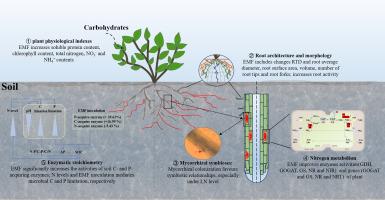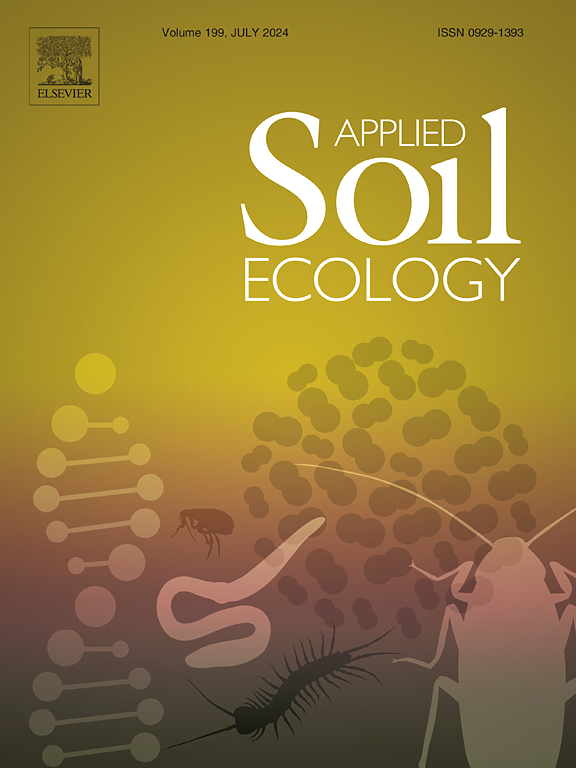Vaccinium corymbosum interact with mycorrhizal fungi to affect nitrogen metabolism and alleviate soil nutrient limitation
IF 4.8
2区 农林科学
Q1 SOIL SCIENCE
引用次数: 0
Abstract
By helping their hosts access soil nitrogen (N), ericoid mycorrhizal fungi (EMF) perform a crucial role in ecosystem processes. However, how plants sense and take up N during EMF symbiosis and the integration of EMF in the soil N cycle with the analysis of N balance and symbiotic dynamics is still far from being well understood. In this study, the experimental system of EMF Oidiodendron maius 143 inoculated and non-inoculated blueberry plants under three N levels were established. Results showed that EMF inoculation significantly improved plants soluble protein content, chlorophyll content, total N, NO3− and NH4+ contents, and mediated changed in root configuration under low N treatments. EMF-inoculated plants significantly increased the activities of N-related enzymes and up-regulated N metabolism genes. However, as the N level rose, these effects eventually disappeared and the rate of EMF colonization significantly decreased. Congruently, EMF inoculation also significantly alleviated microbial N limitation under low N conditions. EMF inoculation and soil organic carbon were the main causes of microbial P limitation by influencing soil available P, and N levels directly regulated P limitation. Microbial C limitation was mainly mediated by N levels, pH and soil N:P ratios, where N levels mediate soil acidification. In conclusion, our results suggested that low N levels favored blueberry symbiosis with EMF, and N levels influenced C, P, and N limitation of soil microbial communities, where mycorrhizal fungi may play an important role in balancing nutrient stoichiometry.

越橘与菌根真菌相互作用,影响氮代谢,缓解土壤养分限制
麦角菌根真菌(EMF)通过帮助宿主获取土壤中的氮(N),在生态系统过程中发挥着至关重要的作用。然而,人们对EMF共生过程中植物如何感知和吸收氮,以及EMF在土壤氮循环中的整合、氮平衡和共生动态分析等问题还知之甚少。本研究建立了三种氮水平下 EMF Oidiodendron maius 143 接种和非接种蓝莓植株的实验系统。结果表明,在低氮处理条件下,接种 EMF 能显著提高植物的可溶性蛋白含量、叶绿素含量、总氮、NO3- 和 NH4+ 含量,并促进根系构造的改变。接种 EMF 的植株能明显提高氮相关酶的活性,并上调氮代谢基因。然而,随着氮水平的升高,这些影响最终消失,EMF 的定植率也明显下降。同样,在低氮条件下,接种 EMF 也能显著缓解微生物的氮限制。EMF接种和土壤有机碳是影响土壤可利用P的微生物P限制的主要原因,而氮水平直接调节P限制。微生物对碳的限制主要受氮含量、pH 值和土壤氮磷比的影响,其中氮含量对土壤酸化有调节作用。总之,我们的研究结果表明,低氮水平有利于蓝莓与EMF共生,氮水平影响土壤微生物群落的碳、磷和氮限制,其中菌根真菌可能在平衡养分平衡中发挥重要作用。
本文章由计算机程序翻译,如有差异,请以英文原文为准。
求助全文
约1分钟内获得全文
求助全文
来源期刊

Applied Soil Ecology
农林科学-土壤科学
CiteScore
9.70
自引率
4.20%
发文量
363
审稿时长
5.3 months
期刊介绍:
Applied Soil Ecology addresses the role of soil organisms and their interactions in relation to: sustainability and productivity, nutrient cycling and other soil processes, the maintenance of soil functions, the impact of human activities on soil ecosystems and bio(techno)logical control of soil-inhabiting pests, diseases and weeds.
 求助内容:
求助内容: 应助结果提醒方式:
应助结果提醒方式:


